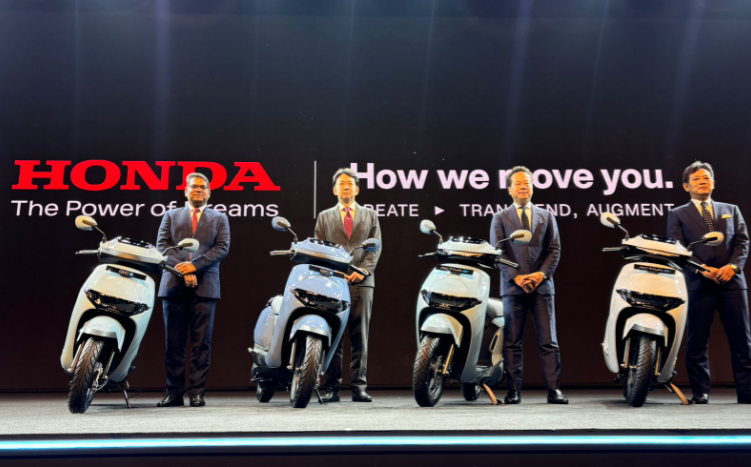
New Delhi: When Honda recently unveiled its electric scooters in Bengaluru, the first reaction among industry circles was that they were “underwhelming” and clearly fell short of expectations. “Coming from Honda, this did not quite create the hype that we thought it would,” said a top executive.
The fact that the Japanese automaker has not announced their prices yet was even more intriguing but as he added, “Never underestimate Honda, it slowly builds up the script and then comes out all guns blazing.” Clearly, with its electric foray, the company is taking one thing at a time and the focus will be on carefully researching all the market feedback and then getting back to the drawing board to plan its next range of products.
It is also quite evident that the Activa e: with the swappable battery option is not intended for the mass market and will be confined to a few cities. The initial presence is being restricted to Bengaluru, Mumbai and Delhi which is keeping pace with the plans of Honda Power Pack Energy India that will operate Honda e:Swap, the battery sharing service.
The press release from Japan states that this move is intended to provide customers a “mobility experience with more peace of mind” by freeing them from the “anxiety of running out of battery power and the waiting time for recharging”.
Moot point
Whether this objective will be met remains a moot point. Carrying the batteries for swapping is not exactly simple for everyone since they are heavy. This could become a daunting task for some customers who may just not be able to pull off something like this. As some sceptics add, “Indians are also not used to doing things on their own and would rather have someone chip in.”
The other perceived drawback with Activa e: is that it does not have enough storage space for keeping a helmet and other vital accessories. Whether this will deter customers is once again the million dollar question but these are early days yet and, more importantly, its price tag is still awaited. What goes in its favour is the sheer brand pull given Activa’s dominance in the ICE space for over two decades now where its closest challenger in gearless scooters trails way behind.
Additionally, Honda has been growing from strength to strength since the time it parted ways with its original ally, Hero, nearly 15 years ago. It went on a massive capacity expansion spree and this year could just see it emerge the top player in India going by the current sales momentum. If this happens, it will be the first time it will have surpassed Hero since their divorce.
QC1, the other electric offering, has been described as a moped that offers optimal dynamic performance for daily short-distance travel such as “commuting to school”. From its manufacturer’s point of view, it is an optimal choice for customers who place “high priority on economic efficiency”.
Dedicated charger
Unlike the Activa e: QC1’s battery can be recharged at home using a dedicated charger. It also offers a luggage compartment under the seat provides space for storing a helmet and other small items. On a lighter note, there is still no indication what QC stands for — is it an abbreviation for quick commerce (the intended market segment), quick charging (a big strength) or quality control (the Honda DNA)?
Perhaps the scooter will have a wholesome name at the time of its pricing though it is more likely that Honda will continue with QC1 which would have registered among all its interested customers by then. On the face of it, Honda will price this scooter aggressively to take on Ola Electric, TVS Motor and Bajaj Auto which are currently ruling the roost in the electric two-wheeler space.
Ola has recently launched scooters with a price tag of less than INR 40,000 and Honda will be watching market reaction to these products carefully. Ola has had its share of troubles recently and will be aware that Honda is a huge brand which produces nearly 20 million two-wheelers worldwide with market leadership in most countries.
Both Activa e: and QC1 are the 12th and 13th models respectively in its overall target of launching 30 electric models globally by 2030. This will translate into four million two-wheelers over the next six years which perhaps gives an indication of the rapid ramp-up planned ahead.
For India, Honda is introducing models exclusively for the market “incorporating local characteristics and customer preferences”. The company has positioned 2024 as the first year for its global expansion of electric motorcycles and has announced two models in Indonesia this year. It has stated that it will accelerate its efforts to develop a full lineup of electric motorcycles, including commuters, to meet wider customer needs.
Modular platforms
In a recent corporate update, Honda has stated that its strengths lie in offering a full lineup of products; development, production and procurement capability amassed through the internal combustion engine business; electric models featuring the fundamental functionality of motorcycles – accelerating/ cruising, turning and stopping – as well as connectivity; and offering integrated online and offline customer touch points through utilisation of a sales network with 30,000 dealership locations worldwide.
There will be utilisation of modular platforms where leveraging knowhow of platform sharing amassed through ICE business — the battery, power unit and chassis of electric two-wheelers — are modularised respectively. Consequently, this use of modular platforms will enable “efficient introduction of models that accommodate the diverse needs of customers around the world”.
To learn more about the electric vehicle ecosystem and meet the key industry leaders, click here.















